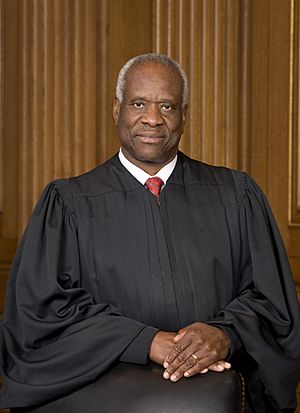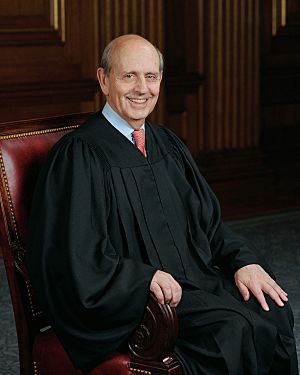J. E. M. Ag Supply, Inc. v. Pioneer Hi-Bred International, Inc. facts for kids
Quick facts for kids J. E. M. Ag Supply, Inc. v. Pioneer Hi-Bred International, Inc. |
|
|---|---|

|
|
| Argued October 3, 2001 Decided December 10, 2001 |
|
| Full case name | J. E. M. Ag Supply, Inc., DBA Farm Advantage, Inc., et al. v. Pioneer Hi-Bred International, Inc. |
| Docket nos. | 99-1996 |
| Citations | 534 U.S. 124 (more)
122 S. Ct. 593; 151 L. Ed. 2d 508; 2001 U.S. LEXIS 10949; 70 U.S.L.W. 4032; 60 U.S.P.Q.2d 1865
|
| Prior history | 200 F.3d 1374 (Fed. Cir. 2000); cert. granted, 531 U.S. 1143 (2001). |
| Subsequent history | Sub nom. Pioneer Hi-Bred Int'l, Inc. v. Ottawa Plant Food, Inc., 283 F. Supp. 2d 1018 (N.D. Iowa 2003) |
| Argument | Oral argument |
| Opinion Announcement | Opinion announcement |
| Holding | |
| Newly developed plant breeds fall within the subject matter of 35 U.S.C. § 101, and neither the Plant Patent Act nor the Plant Variety Protection Act limits the scope of § 101's coverage. | |
| Court membership | |
| Case opinions | |
| Majority | Thomas, joined by Rehnquist, Scalia, Kennedy, Souter, Ginsburg |
| Concurrence | Scalia |
| Dissent | Breyer, joined by Stevens |
| O'Connor took no part in the consideration or decision of the case. | |
| Laws applied | |
| 35 U.S.C. § 101, 7 U.S.C. § 2321, and 35 U.S.C. §§ 161–164 | |
J. E. M. Ag Supply, Inc. v. Pioneer Hi-Bred International, Inc. was an important case decided by the Supreme Court of the United States in 2001. This case was about whether new types of plants, especially those that reproduce by seeds (like corn), could be protected by a special kind of invention protection called a "utility patent."
Before this case, it was unclear if these plants could get utility patents. There were other laws, like the Plant Variety Protection Act (PVPA) and the Plant Patent Act of 1930 (PPA), that offered some protection for plants. But these laws were different from utility patents. The Supreme Court decided that utility patents could be given for these plants. This meant that the PVPA and PPA were not the only ways to protect new plant inventions.
Contents
Background of the Case
Pioneer's Patented Seeds
Pioneer Hi-Bred International, Inc. is a company that creates and sells special kinds of hybrid corn seeds. They had "patents" on these seeds. A patent is like a special permission from the government. It gives the inventor the right to stop others from making, using, or selling their invention for a certain time.
When Pioneer sold its patented seeds, they came with a special rule. This rule was printed on the bag. It said that the seeds could only be used to grow corn for food or animal feed. It also said that farmers could not use the seeds from their harvest to plant new crops. They also could not use them to create new types of seeds.
The Dispute Begins
J.E.M. Ag Supply, Inc., which also went by Farm Advantage, Inc., bought some of these patented corn seeds from Pioneer. But instead of just using them to grow corn, Farm Advantage resold the bags of seeds. They did this without Pioneer's permission.
Because of this, Pioneer sued Farm Advantage and some of its sellers and customers. Pioneer said that Farm Advantage was breaking their patent rules. They claimed that Farm Advantage was "infringing" on their patents. This means they were using Pioneer's invention without permission.
Farm Advantage's Argument
Farm Advantage argued that Pioneer's patents on corn plants were not valid. They said that plants that reproduce by seeds, like corn, should not be able to get utility patents. They believed that the Plant Variety Protection Act (PVPA) and the Plant Patent Act (PPA) were the only laws meant to protect new plants.
Farm Advantage thought these specific plant laws should be the only way to protect plants. They felt that allowing utility patents for plants would upset the way Congress planned to protect them. For example, the PVPA allows farmers to save seeds from their crops to plant again later. Utility patents do not have this same rule.
Decisions by Lower Courts
District and Federal Courts
The case first went to a local court called the United States District Court for the Northern District of Iowa. This court decided against Farm Advantage. Then, Farm Advantage appealed the decision to a higher court, the United States Court of Appeals for the Federal Circuit. This court also agreed with Pioneer. They said that Farm Advantage had indeed broken Pioneer's patent rules.
The main question these courts looked at was: Can seeds and plants that reproduce by seeds be protected by utility patents? Both courts said "yes." They believed that these plants could be patented under the general patent law.
Supreme Court Decision
The Court's Main Opinion
The case then went to the highest court in the United States, the Supreme Court. Clarence Thomas, one of the Supreme Court Justices, wrote the main decision for the Court. Six out of eight Justices agreed with his opinion.
The Court looked back at a similar case from 20 years earlier, called Diamond v. Chakrabarty. In that case, the Court had decided that a man-made microorganism (a tiny living thing) could get a utility patent. The Court had said that the important difference was not between living and non-living things. Instead, it was between things found in nature and inventions made by humans.
Farm Advantage did not argue that plants were not "manufactures" or "compositions of matter" (terms used in patent law). Their main argument was that Congress meant for the PVPA and PPA to be the only ways to protect plant inventions.
However, the Supreme Court disagreed with Farm Advantage. The Court explained that when Congress passed the Plant Patent Act in 1930, they thought plants could not be protected by regular patent law. But the Court said that the Chakrabarty case showed that Congress was mistaken. Living things could be patented if they were human-made inventions.
The Court said that the PVPA and PPA work alongside the general utility patent law. They offer different kinds of protection and have different rules. The newer plant-specific laws do not cancel out the older, general patent law.
The Supreme Court concluded that new types of plants can indeed get utility patents. They said that neither the PPA nor the PVPA stops this from happening. The Court did not want to limit the reach of the general patent law unless Congress clearly said that was their intention.
The Dissenting Opinion
Two Justices, Stephen Breyer and John Paul Stevens, disagreed with the majority. Justice Breyer wrote their dissenting opinion. They believed that the words "manufacture" and "composition of matter" in the general patent law should not cover crop plants that reproduce by seeds.
They thought that the two specific plant laws (PPA and PVPA) were meant to be the only way to protect these kinds of plants. Justice Breyer also argued that the Chakrabarty case did not answer the question about patenting plants like corn. He said that Chakrabarty was about bacteria, which are very different from the plants covered by the PPA and PVPA.
Justice Breyer felt that the majority did not look closely enough at what Congress intended when they created these laws.
What Happened After the Supreme Court Case
The Ottawa Plant Food Case
After the Supreme Court made its decision, the case went back to the lower courts. Ottawa Plant Food, Inc. was one of the companies that had bought Pioneer's corn seeds from J.E.M. Ag Supply. All the other companies involved in the lawsuit settled with Pioneer. This left Ottawa as the only company still fighting the case.
Ottawa argued that they should not be held responsible because of something called the "patent exhaustion doctrine." This idea suggests that once a patented item is sold, the patent owner loses some control over it. However, the court disagreed. It said that Pioneer had clearly put rules on the seed bags. These rules limited how the seeds could be used or resold. The court decided that Pioneer was right and Ottawa was responsible.
Ottawa also argued that Pioneer's rules were unfair or against public policy. They said the rules might stop competition. But the court rejected this argument too. It said that Pioneer's rules were allowed.
Later Developments: The Bowman Case
Several years later, in 2013, the Supreme Court heard another important case called Bowman v. Monsanto Co.. In this case, the Court assumed that the J.E.M. Ag Supply case and the Chakrabarty case had already settled the question of whether crop plants could be patented.
In the Bowman case, the Court decided that farmers who saved seeds from patented crops and then planted them again were breaking patent law. This decision was made without any disagreement from the Justices, including Justice Breyer, who had dissented in the J.E.M. Ag Supply case. This showed that the idea of patenting plants had become more accepted.



